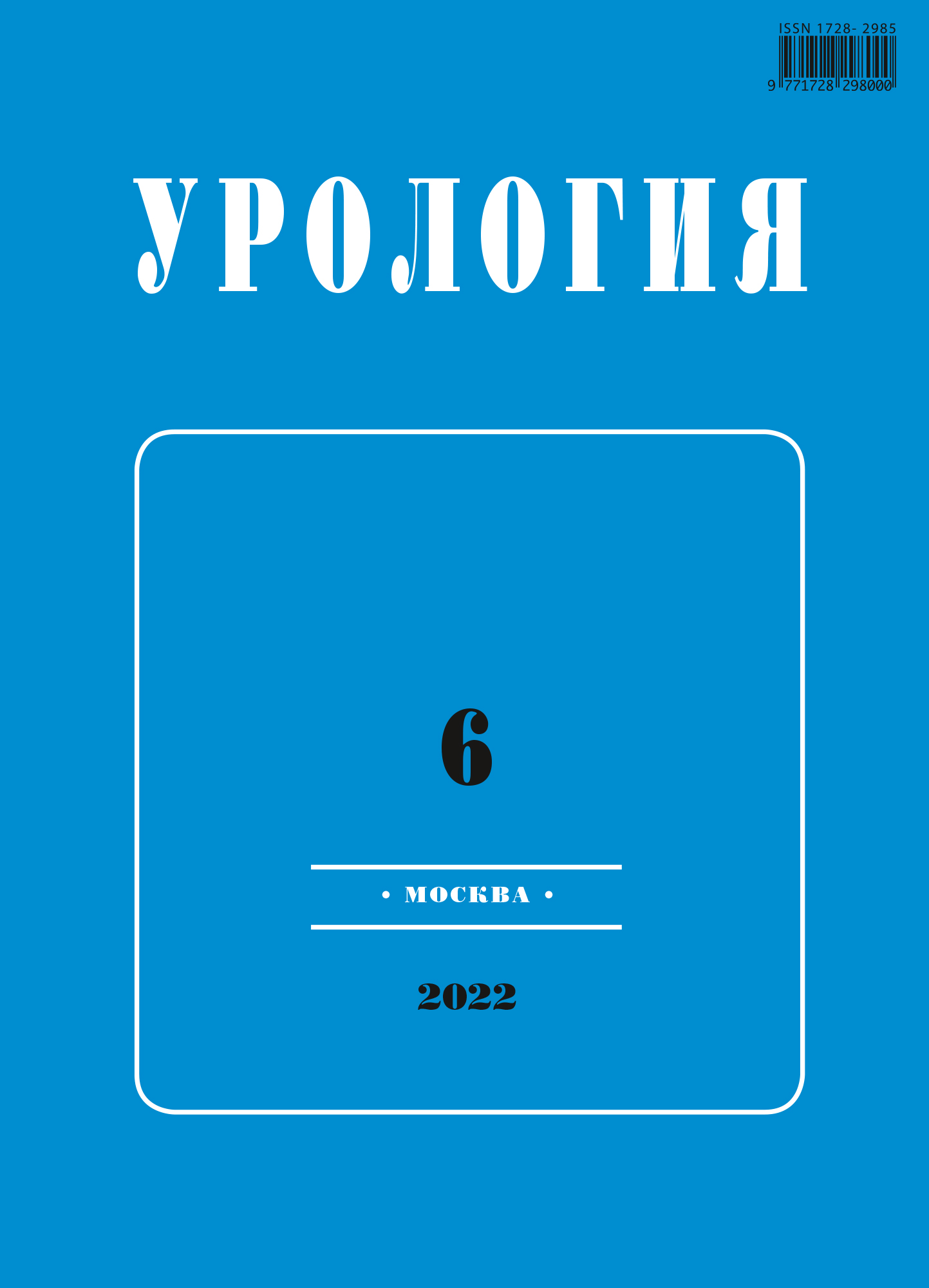Антибиотикорезистентность штаммов грамположительных кокков, выделенных из секрета предстательной железы мужчин с хроническим бактериальным простатитом
- Авторы: Карташова О.Л1, Пашинина О.А1, Морозова Н.В1, Пашкова Т.М1, Кузьмин М.Д1
-
Учреждения:
- Институт клеточного и внутриклеточного симбиоза УрО РАН
- Выпуск: № 6 (2022)
- Страницы: 16-20
- Раздел: Статьи
- URL: https://journals.eco-vector.com/1728-2985/article/view/277075
- DOI: https://doi.org/10.18565/urology.2022.6.16-20
- ID: 277075
Цитировать
Полный текст
Аннотация
Полный текст
Об авторах
О. Л Карташова
Институт клеточного и внутриклеточного симбиоза УрО РАН
Email: labpersist@mail.ru
д.б.н., доцент, ведущий научный сотрудник лаборатории персистенции и симбиоза микроорганизмов Оренбург, Россия
О. А Пашинина
Институт клеточного и внутриклеточного симбиоза УрО РАН
Email: olga25mikro@mail.ru
к.б.н., старший научный сотрудник лаборатории персистенции и симбиоза микроорганизмов Оренбург, Россия
Н. В Морозова
Институт клеточного и внутриклеточного симбиоза УрО РАН
Email: natascha210994@mail.ru
к.б.н., научный сотрудник лаборатории персистенции и симбиоза микроорганизмов Оренбург, Россия
Т. М Пашкова
Институт клеточного и внутриклеточного симбиоза УрО РАН
Email: pashkova070782@mail.ru
д.б.н., ведущий научный сотрудник лаборатории персистенции и симбиоза микроорганизмов Оренбург, Россия
М. Д Кузьмин
Институт клеточного и внутриклеточного симбиоза УрО РАН
Email: mdk-49@mail.ru
д.м.н., ведущий научный сотрудник лаборатории по изучению механизмов формирования микробных биоценозов человека; академии наук, врач-уролог высшей квалификационной категории, консультант ГАУЗ ООКБ, заслуженный врач РФ и Республики Мордовия Оренбург, Россия
Список литературы
- Божедомов В.А. Современные возможности лечения хронического простатита. Обзорная статья. Андрология и генитальная хирургия. 2016;17(3):10-22.
- Holt J.D., Garrett W.A., McCurry T.K., Teichman J.M.Common questions about chronic prostatitis: a systematic review. Am. Fam. Physician. 2016;93(4):29-0296 / PMID: 26926816
- Коган М.И., Набока Ю.Л., Исмаилов Р.С., Белоусов И.И., Гудима И.А. Бактериальный простатит: эпидемиология и этиология. Урология. 2018;6:144-148). Doi: https://dx.doi.org/10.18565/urology.2018.6.144-148.
- Ибишев Х.С., Набока Ю.Л., Мамедов Э.А., Крайний П.А., Манцев А.А., Коган М.И. Резистентность к антибактериальным препаратам у пациентов с хроническим рецидивирующим бактериальным простатитом. Материалы XXI конгресса Российского общества урологов. Урология. 2021; Приложение 5:461-462.
- Maslak E., Mista W., Zloch M. et al., A new approach to imaging and rapid microbiome identification for prostate cancer patients. Biomedicines. 2022;10:1806. Doi: 10.339/biomedicines10081806.
- Cai T., Mazzoli S., Meacci F. Epidemiological features and resistance pattern in uropathogens isolated from chronic bacterial prostatitis. J. Microbiol.2011;49(3):448-454. doi: 10.1007/s12275-011-0391-z.
- Stamatiou K., Magri V., Perletti G. et al. Gram-positive microorganisms isolated during chronic bacterial prostatitis investigation. A retrospective study. Hellenic Urology. 2019;30(4):35-49.
- Медведев В.Л., Ефремов М.Е. Эффективность применения препарат аденопросин в комплексном лечении пациентов с хроническим бактериальным простатитом. Инновационная медицина Кубани. 2020;3(19):45-50.
- Коган М.И., Набока Ю.Л., Исмаилов Р.С. Микробиота секрета простаты: сравнительный анализ хронического простатита категорий II и IIIA. Урология. 2020;2:16-22). Doi: https://dx.doi.org/10.18565/urology.2020.2.16-22.
- Heras-Canas V., Gutierrez-Soto B., Serrato-Garcia M.L. et al. Chronic bacterial prostatitis. Clinical and microbiological study of 331 cases. Med. Clin. 2016.19;147(4):144-147.
- Локшин К.Л. Актуальные вопросы лечения бактериальных и абактериальных простатитов: каковы показания для антибактериальной и фитотерапии? Урология и нефрология. 2016;4:6-9.
- Alberto Trinchieri, Khalid Mohammed Abdelrahman, Kamran Hassan Bhatti, Jibril O. Bello, Krishanu Das, Ognyan Gatsev, Ivanka Gergova, Vittorio Magri, Nikos Mourmouras, Panagiotis Mourmouris, Soni Murdeshwar. Spectrum of Causative Pathogens and Resistance Rates to Antibacterial Agents in Bacterial Prostatitis. Diagnostics. 2021;11:1333. Doi: https://doi.org/10.3390/diagnostics11081333.
- Litwin M.S., McNaughton-Collins M., Fowler FJ Jr, Nickel JC, Calhoun E.A., Pontari M.A., Alexander R.B., Farrar J.T., O’Leary M.P. The National Institutes of Health chronic prostatitis symptom index: development and validation of a new outcome measure. Chronic Prostatitis Collaborative Research Network. J Urol. 1999;162:369-375. doi: 10.1016/s0022-5347(05)68562-х.
- Rosen R.C., Cappelleri J.C., Smith M.D., Lipsky J., Pena B.M. Development and evaluation of an abridged, 5-item version of the International Index of Erectile Function (IIEF-5) as a diagnostic tool for erectile dysfunction.Int J Impot Res. 1999;11(6):319-326. doi: 10.1038/sj.ijir.3900472.
- ГОСТ Р 52379-2005 Надлежащая клиническая практика. Москва: Стандартинформ, 2006;33 с.
- МУК 4.2.1890-04 Определение чувствительности микроорганизмов к антибактериальным препаратам. М.: Минздрав России, 2005;62 c.
- Gostev V., Kruglov A., Kalinogorskaya O., Dmitrenko O., Khokhlova O.E., Yamamoto T., Lobzin Y., Ryabchenko I., Sidorenko S. Molecular epidemiology and antibiotic resistance of methicillin-resistant Staphylococcus aureus circulating in the Russian Federation. Infection, Genetics and Evolution. 2017;53:189-194.
- Лакин Г.Ф. Биометрия. М.: Высшая школа,1990; 352 с.
- Божедомов В.А. Хронический простатит: новая парадигма лечения. Урология. 2016;3:78-90.
- Stamatiou K., Pierris N. Mounting resistance of uropathogens to antimicrobial agents: A retrospective study in patients with chronic bacterial prostatitis relapse. Department of Urology, Tzaneio General Hospital of Piraeus, Piraeu Investig Clin Urol 2017;58:271-280. Doi: https://doi.org/10.4111/icu.2017.58.4.271.
- Chow J.W. Aminoglycoside resistance in enterococci. Clin Infect Dis. 2000; 31(2):586-589. Doi: 10.1086/313949' target='_blank'>https://doi: 10.1086/313949.
- Amini F., Krimpour H.A., Ghaderi M., Vaziri S., Ferdowsi S., Azizi M. Prevalence of aminoglycoside resistance genes in Enterococcus strains in Kermanshah, Iran. Iran J Med Sci. 2018; 43(5):487-493.
- Abdelkareem M.Z., Sayed M., Hassuna N.A., Mahmoud M.S., Abdelwahab S.F. Multi-drug-resistant Enterococcus faecalis among Egyptian patients with urinary tract infection. J Chemotherapy. 2017;29(2):74-82. doi: 10.1080/1120009X.2016.182358.
- Zhu L.X., Zhang Z.W., Wang C., Yang H.W., Jiang D., Zhang Q., Mitchelson K., Cheng J. Use of a DNA microarray for simultaneous detection of antibiotic resistance genes among staphylococcal clinical isolates. J. Clin. Microbiol. 2007;45:3514-3521. doi: 10.1128/JCM.02340-06.
- Шаркова В.А., Лайман Е.Ф., Мазур М.Е. Генетически обусловленная патогенность и антибиотикорезистентность штаммов Staphylococcus spp. Тихоокеанский медицинский журнал. 2014;3:46-49.
- Jung-Whan Chon, Un Jung Lee, Ryan Bensen, Stephanie West, Angel Paredes, Jinhee Lim, Saeed Khan, Mark E. Hart, K. Scott Phillips, Kidon Sung. Virulence Characteristics of mecA-Positive Multidrug-Resistant Clinical Coagulase-Negative Staphylococci. Microorganisms. 2020;8:659. doi: 10.3390/microorganisms8050659/.
- Зайцев А.А., Карпов О.И., Сидоренко С.В. Стафилококки и ванкомицин: тенденции и противостояния. Антибиотики и химиотерапия. 2003;48(6):20-26.
- Miller W.R., Munita J.M., Arias C.A. Mechanisms of antibiotic resistance in enterococci. Expert Rev Anti Infect Ther. 2014;12(10):1221-1236. Doi: 10.1586/ 14787210.2014.956092.
- Коменкова Т.С., Зайцева Е.А. Современные представления о механизмах резистентности к антимикробным препаратам Enterococcus faecalis и Enterococcus faecium. Антибиотики и химиотерапия. 2020;65(11-12): 38-48. Doi: https://doi.org/10.37489/0235-2990-2020-65-11-12-38-48.
- Partridge Sally R., Kwong Stephen M., Firth Neville, Jensen Slade O. Mobile Genetic Elements Associated with Antimicrobial Resistance. Clin Microbiol Rev. 2018;31(4 doi: 10.1128/CMR.00088-17.
Дополнительные файлы








